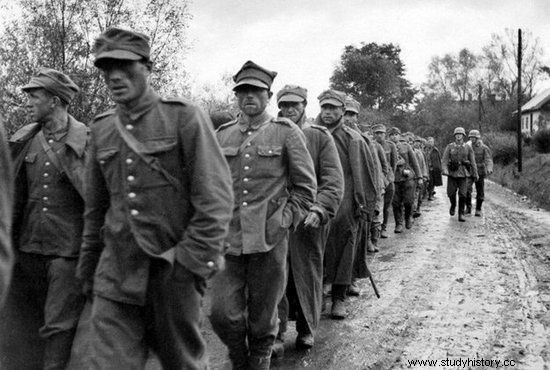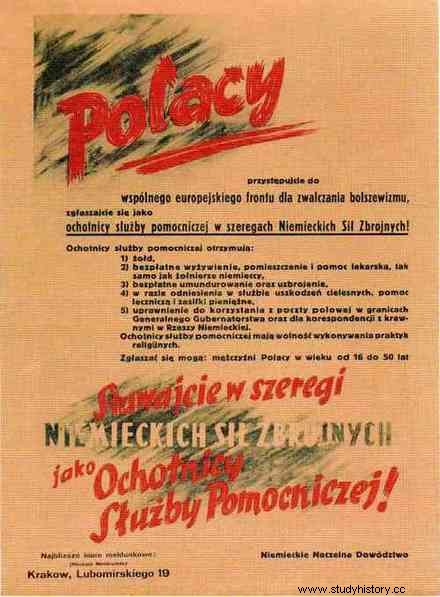The Germans despised Poles throughout the war. It was only when the Red Army stood at the gates of the General Government that they remembered that these "subhumans" were also excellent candidates for soldiers. In 1944 they decided to create a Polish army alongside the Wehrmacht.
In order to involve Polish society in the fight against the Soviets, the Nazis prepared a wide-ranging propaganda campaign. Within its framework, references were made to the myth of Józef Piłsudski. In the summer of 1944, the absurdity reached its peak. Krakow governor Kurt Ludwig Burgsdorff organized an academy in honor of Polish soldiers who died in the fight against the Bolshevik onslaught in 1920!
Reproductions of anti-Bolshevik posters from 1919-1920 were also distributed, and millions of copies of leaflets and posters were printed, calling on Poles to stand by the side of the Wehrmacht. The occupiers even tried to recruit members of the Polish underground to fight the Red Army, but in most cases it was to no avail.

Wanting to win over Poles, the Germans started to refer to the Polish-Bolshevik war and to play the person of Marshal Piłsudski.
Germany organizes Polish armed auxiliary forces
In this situation - as Prof. Andrzej Chwalba - The Germans decided against the Home Army and outside it, also outside the BCh and NSZ, to create from scratch Polish auxiliary armed forces in the German army . The first concrete decisions were made on November 4, 1944. It was on this day that the occupation authorities established the rules for the organization of the above-mentioned formation. Interestingly, the Germans assumed that its ranks would be joined mainly by officers and soldiers taken prisoner in 1939 and ... former Warsaw insurgents !
Okay, but what was to convince potential volunteers to stand by the Wehrmacht, which was getting skinned by the Soviets? Posters hung up since mid-November ensured that every man aged 16 to 50 could count on:
1) pay
2) free food, room and medical assistance, same as for German soldiers.
3) free uniforms and weapons.
4) in case of bodily injury service, medical help and cash benefits.
5) permission to use field mail within the General Government and for correspondence with relatives in the German Reich.

According to German plans, the core of the Polish auxiliary forces was to be officers and soldiers taken prisoner in 1939 and former Warsaw insurgents. Such an assumption actually condemned the entire undertaking to failure. The photo shows the soldiers of the Polish Armed Forces going into German captivity.
Moreover, it was guaranteed that Volunteers of the Auxiliary Service would have complete freedom to practice their religion. What a tempting offer, nothing but a puff. At least that is what the Germans must have thought, since they hoped that 12,000 volunteers would apply in the first stage, and in the long run there would be 150,000 to 175,000 of them! This is just optimism for you.

With such posters, the Germans encouraged Poles to join the ranks of the auxiliary armed forces
Meanwhile, the reality was not so rosy. Obviously, the entire campaign was not well received among Poles. However, the Germans did not intend to give up and only intensified their propaganda campaign! As Tadeusz Kwiatkowski wrote in his memoirs - quoted in the book "Kraków - time of occupation 1939-1945" - Tadeusz Kwiatkowski:
On Karmelicka Street I see a marching unit of German soldiers with white and red armbands and singing with a bad Polish accent The green stem is bending. I am amazed and only the car with a camera on the roof passing by and filming this march explained everything to me. The German propaganda wants to show in this chronicle how the Poles in large numbers and eagerly took up the appeal of the authorities and entered the service in the Wehrmacht. […] Poles or non-Poles - How Poles are there! - The old man taps his finger on the forehead. - Costumes, volksdeutsche!
Poles do not embrace German wings
Undeterred by the lack of success, the Germans opened the main recruitment office in the General Government on 23 November at 19 Lubomirskiego Street in Krakow. At the same time, in Zwierzyniec, the formation of an infantry company of 170 men began, whose soldiers were dressed in ... Slovak uniforms.

However, despite the efforts made, the appeals to Poles remained virtually unanswered. As prof. Andrzej Chwalba, by the end of the year, only 471 volunteers joined the ranks of the auxiliary armed forces.
The Germans themselves claimed that 9,000 had turned up. Indeed, the recruitment looked good on paper. By what miracle? Well, the registration of candidates started with the number of five thousand. In addition, some of the "volunteers" were probably prisoners released for the price of joining a collaborative formation.
In reality, the entire undertaking aimed at using the Poles to fight the advancing Red Army ended in a complete failure. Thanks to this, we can now be proud of the fact that we have not set up a single collaborative military formation ...
